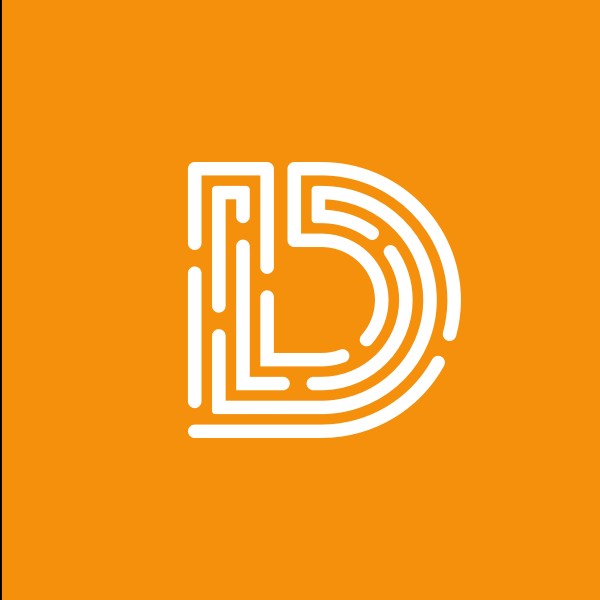Ordinals ecology explodes, Ordinals core knowledge sharing that even novices can understand (with tutorial)
1. What are Ordinals?
The Ordinals protocol is a system for numbering Satoshis (the smallest unit of Bitcoin, 1 BTC = 100 million Satoshis) in the order they are mined, and tracking them in transactions. For example, the first Bitcoin to be mined had a Satoshi number of 1-100000000.
The numbered Satoshi becomes the only Satoshi and is no longer homogeneous. Every Satoshi is unique.
At the same time, Cong is transferred from transaction input to transaction output according to the first-in, first-out principle. Both the numbering scheme and the transfer (transaction) scheme rely on order, the numbering scheme relies on the order in which satoshis are mined, and the transfer scheme relies on the order of transaction inputs and outputs. Therefore, this scheme is named Ordinals protocol.
2. What are inscriptions?
"Inscriptions"is a protocol that allows arbitrary content (such as files in text, images, videos, html, etc. formats) to be attached to a single satoshi, thereby transforming it into a native digital artwork on the Bitcoin chain.
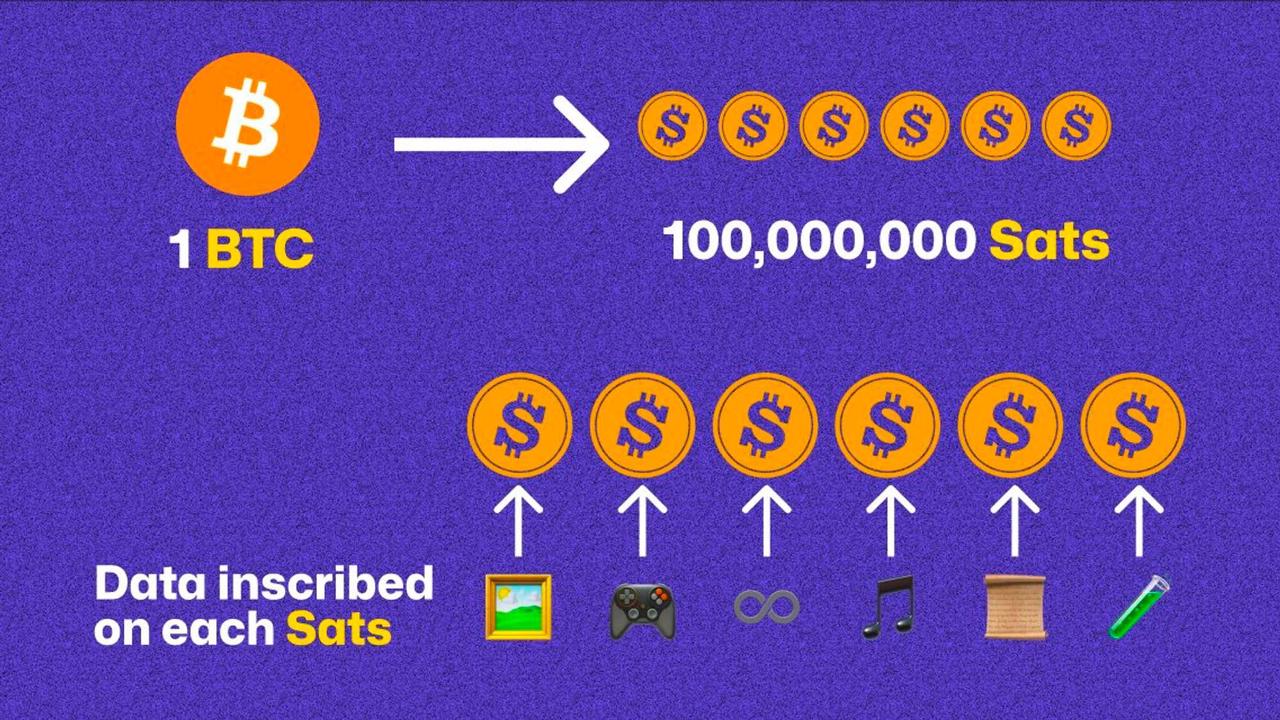
Pictures come from the Internet
The process of engraving inscriptions is achieved by sending a transaction with a Taproot script. Any content is written into the transaction. Once the transaction is packaged on the chain, the satoshis that have engraved the specific content become inscriptions. And the information will be permanently recorded on Bitcoin (Satoshi). Simply put, a Cong with specific information engraved on it is an inscription.
Once an inscription is cast, it is bound to the Satoshi it is inscribed with. However, to prevent dust attacks, Bitcoin has a minimum transaction limit, and the minimum limit for a single transaction is 294 satoshis. So the inscription is not tied to one satoshi, but to at least 294 satoshis. But the inscription tracks not the numbers of the 294 satoshis, but the number of the first satoshi. In this way, the storage, transfer and transaction of inscriptions only need to track specific numbered satoshis.
While traditional NFTs are similar to Ordinals in some ways, there are several key differences. NFTs are typically made on blockchains such as Ethereum, Solana, and BNB Smart Chain using smart contracts, and sometimes the assets they represent are hosted elsewhere. Instead, Ordinals are recorded directly on a single Satoshi and are then included in blocks of the Bitcoin blockchain. Ordinals reside entirely on the blockchain and require no sidechains or separate tokens. In this sense, Ordinals records inherit the simplicity, immutability, security, and durability of Bitcoin itself.
3. What is BRC-20?
BRC-20 is a standard for token issuance based on Ordinals. BRC-20 token issuance and minting is also the process of minting inscriptions. It is also necessary to burn text in a specific format to Satoshi.
This is Ordi’s token deployment inscription information. This content is burned into Satoshi. The transaction is packaged to complete the deployment of the inscription. Here p specifies BRC-20, op is the behavior type, here Deploy is deployment, and others include Mint casting and Transfer transfer. max is the total amount of tokens. lim is the maximum number of tokens contained in an inscription.
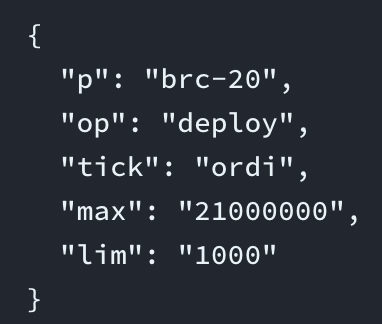
BRC-20 uses JavaScript Object Notation (JSON) serial numbers to deploy token contracts and mint and transfer tokens. Tokens can be attributed to satoshis and then traded or exchanged with other tokens, just like with other tokens.
4. What is the relationship between Ordinals and BRC 20?
Ordinals provide the underlying technology for burning data on the Bitcoin network, while BRC 20 provides the rules for creating and managing tokens using this technology. BRC 20 uses the Ordinals protocol to burn the data representing these tokens onto the blockchain.
To put it simply, Ordinals numbers Satoshis so that each Satoshi has a number and becomes unique. Then the Satoshi number is tracked to realize the recording and tracking of Satoshi. Then by burning information in the inscription, the inscription is made. The Cong number corresponding to the inscription is recorded and tracked, and the storage, recording and transaction of the inscription are completed.
BRC-20 specifies a specific information format burned on Satoshi, which is the rule for the deployment, minting and transfer of BRC-20 tokens. Thus came the BRC-20 token standard. BRC-20 deployment, minting and transfer can be completed according to a specific format. The deployment and minting of tokens follow the principle of First is First, whichever is deployed first shall prevail and whichever is minted first shall prevail. For example, after Ordi is deployed on March 8, a new Ordi cannot be deployed later. For example, if the total amount is 21,000,000, only the 21,000,000 tokens before minting are valid. Although it can be cast according to the casting format after casting, it is considered invalid.
5. What are the differences between Ordinals’ BRC-20 tokens, NFTs and domain names and the Ethereum ecosystem’s tokens, NFTs and domain names?
Tokens: BRC-20 uses a proof-of-work mechanism on the Bitcoin blockchain, while ERC-20 uses a proof-of-stake mechanism on the Ethereum blockchain. The BRC-20 token standard also does not support smart contracts. BRC-20 transactions are based on PSBT technology, and ERC-20 token transactions are based on smart contracts. There are also obvious differences in the distribution and casting of the two. You can refer to the picture below.
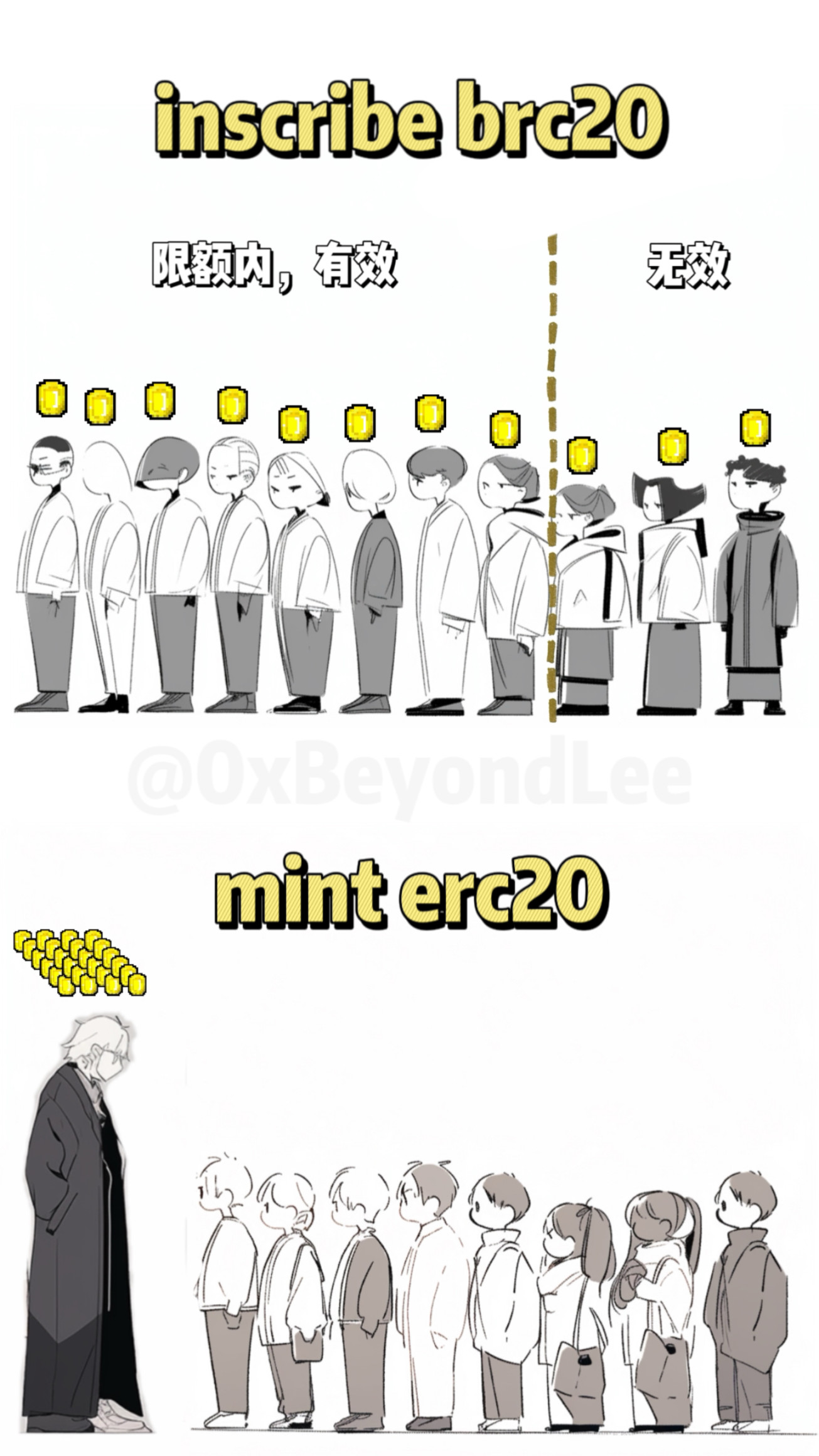
Pictures come from the Internet
NFT: Both Ordinals’ NFTs and traditional NFTs are unique and cannot be tampered with. But from a technical design perspective, Ordinals are different from traditional NFTs. Ordinals NFTs only exist on the blockchain and are completely immutable; while NFTs can exist off-chain.
NFTs on Ethereum usually point to off-chain data on the Interplanetary File System (IPFS: a decentralized file storage system). A bit like the hard drive of a blockchain – it can be changed using dynamic metadata. To illustrate this point, some NFT projects update the metadata of individual NFTs to improve image quality. They may even require their holders to click the Refresh Metadata button on OpenSea to get new, higher quality images.
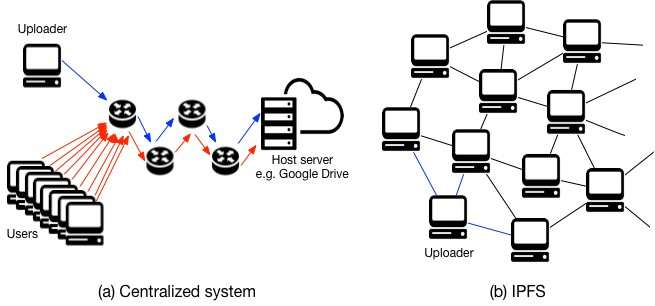
Pictures come from the Internet
In Rodarmors vision, NFTs are incomplete because many require off-chain data. Ordinals, on the other hand, are “complete” in that all data is recorded directly on-chain. Thats why Rodarmor calls them digital art, not Bitcoin NFTs. Additionally, NFTs often come with creator royalties, while digital artwork does not.
Ordinals can be minted directly onto the Bitcoin chain. NFTs usually require a separate minting process on a smart contract platform. All of this suggests that ordinal numbers on Bitcoin may not just mark a cultural change for Bitcoin—they may actually be technological improvements to NFTs.
Another key difference between Bitcoin ordinals is how rarity is derived and priced around NFTs. For traditional Ethereum-based NFTs, the creator typically defines the rarity of the NFT, and subsequently the price.
However, for Bitcoin ordinals, pricing will be defined by the key moments represented by Bitcoin blocks. The first 1,000 or 10,000 inscriptions may still be treasured by collectors. The founders of Ordinals proposed a simple framework whereby key events would determine the rarity of the sat and the inscriptions engraved on it.
Domain name: Ethereum Domain Name Service (ENS) is similar to DNS. But it manages website domain names in a more secure and decentralized way, and can send ETH and ERC-20 tokens through it. The BTC ecological domain name presents a higher decentralization and has the advantages of being fully chained, independently completed, and permanently preserved once minted. ENS costs money to rent, and most domain names in the BTC ecosystem do not need to be renewed. Once minted, they will belong to you forever.
6. Overview and introduction of Ordinals ecological products: wallet, trading market
1. Wallet
1)Unisat
UniSat Wallet is a Chrome plug-in wallet for the BTC ecosystem. It functions like MetaMask and helps users store, mint and transfer BRC-20 tokens, including buying and selling BTC, NFT, domain names, etc.
2) xverse
Xverse is a web3 Bitcoin wallet. The wallet is developed based on the Stacks (STX) platform and is secured by Bitcoin. It can exchange tokens, trade NFTs, access DeFi and other decentralized applications. Ordinals are now supported as well.
3) OKX wallet
Ouyi Web3 Wallet is a non-custodial, decentralized multi-chain wallet with a built-in cross-chain currency exchange transaction aggregator DEX, a one-stop on-chain investment tool DeFi, and a heterogeneous multi-chain aggregation trading platform. Ordinals are currently supported.
2. Trading market
1)iDclub
iDclub is a professional Ordinals trading market and one of the first trading markets to enter the Ordinals ecosystem. Minting fees and transaction fees are very cheap, and it provides the most cost-effective Ordinals NFT and BRC 20 tokens, domain name minting and trading services. Full functionality.
2)Magic Eden on Bitcoin
Magic Eden On Bitcoin is Magic Edens vertical trading market in the BTC chain ecosystem. It supports the issuance and trading of NFT assets in the Ordinals ecosystem. It currently does not support the trading of BRC-20 token assets.
3)unisat
Unisat has a comprehensive Ordinals trading market that provides the minting and buying and selling of domain names, NFTs, and BRC-20 tokens. It has also launched BRC-20 SWAP, currently in closed beta.
7. How to mint BRC-20 tokens?
1) Preliminary preparation
There are many new friends who are new to the circle and don’t know where to start with the minting and buying and selling of BRC 20 tokens. In this article, I will show you in detail how to mint, sell, and buy inscriptions! Before starting, give a layman explanation of the two operations.
Minting: Tokens that have not reached 100% progress can be minted by yourself, commonly known as inscription.
Sale: Tokens are sold, and transfer inscriptions are mainly minted before sale.
Before operation, you need to install the wallet plug-in in the browser (Google Chrome is recommended). The list of wallets supported by iDclub on the computer is as follows:
Unisat Wallet wallet plug-in:
https://chrome.google.com/webstore/detail/unisat-wallet/ppbibelpcjmhbdihakflkdcoccbgbkpo
Xverse Wallet wallet plug-in: https://chrome.google.com/webstore/detail/xversewallet/idnnbdplmphpflfnlkomgpfbpcgelopg?hl=en-GBauthuser=1
OKX Wallet wallet plug-in
https://chrome.google.com/webstore/detail/okx-wallet/mcohilncbfahbmgdjkbpemcciiolgcge
2) How to mint BRC-20 tokens?
After entering iDclub.io, connect to the wallet in the upper right corner of the page
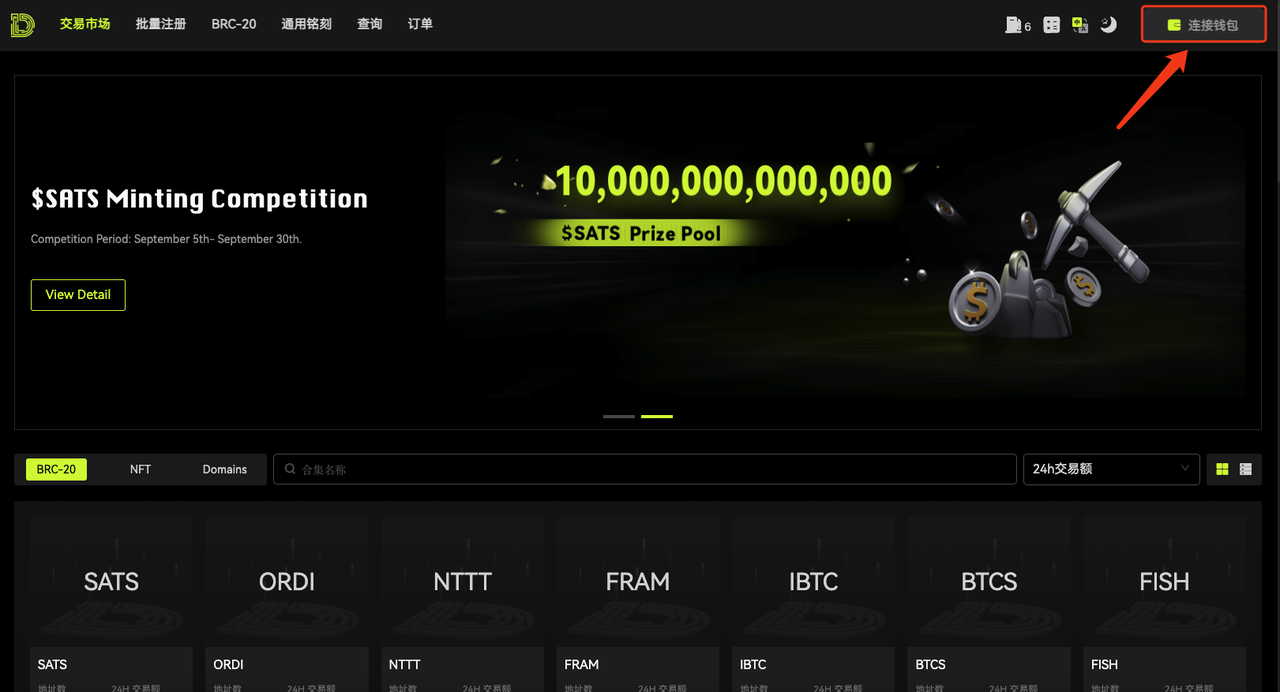
2. Click BRC-20 in the upper left corner of the page and select BRC tokens
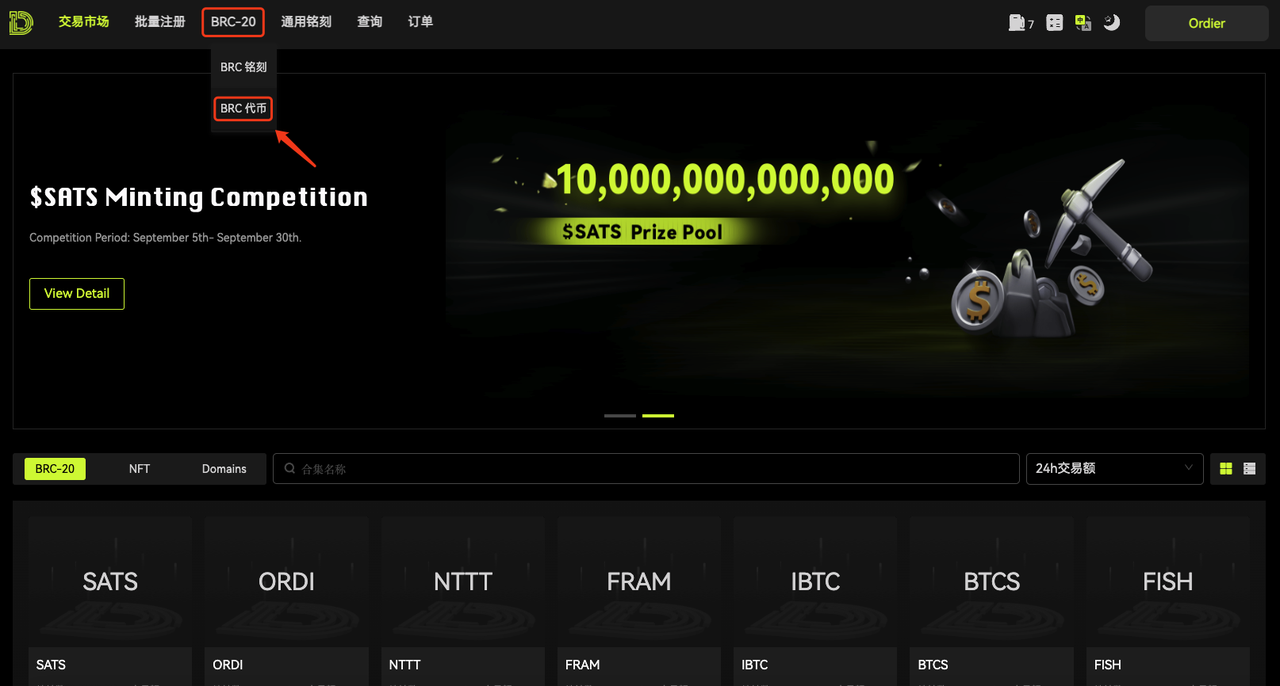
3. Jump to the BRC-20 minting page and fill in the name of the token to be minted, the number of tokens contained in a single inscription (the default is the maximum), and the number of tokens
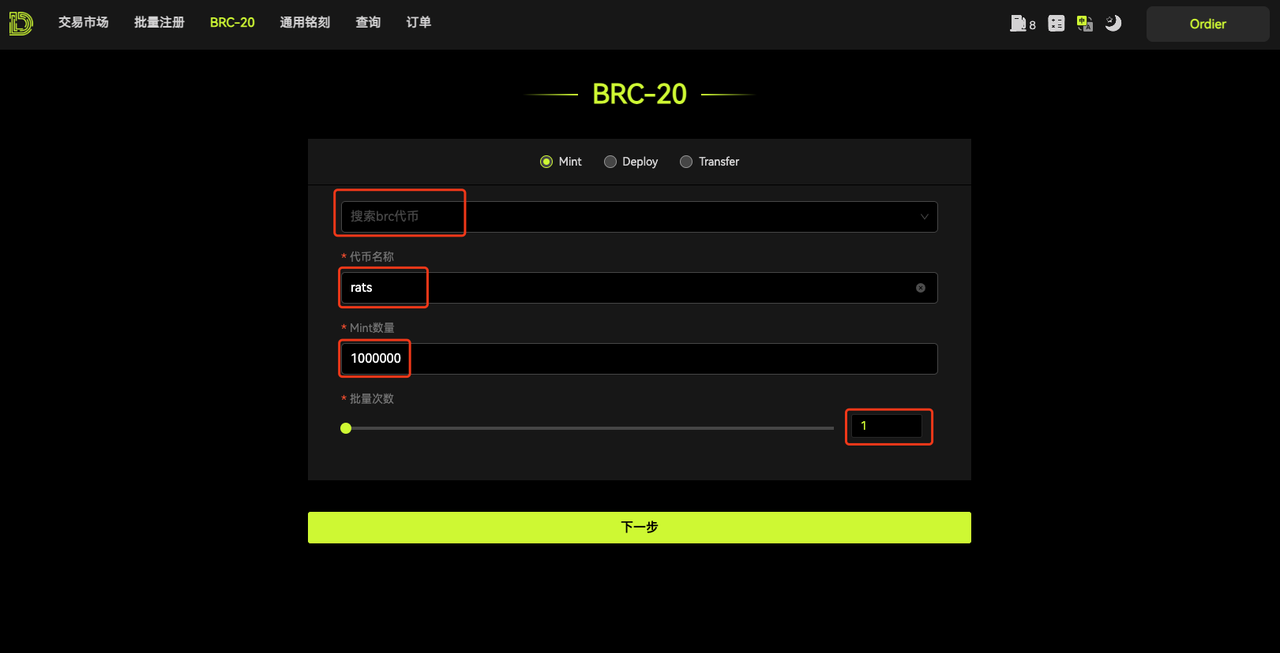
Token name: case insensitive
mint quantity: The deployer specifies the maximum number of tokens contained in a single inscription of the token (the default value, which is the maximum value, does not affect the cost)
Number of batches: the number of inscriptions to be cast (maximum 1,000 in one batch)
Confirm the quantity and click Next to proceed with inscription casting.
4. Determine the receiving address, gas fee, and number of reserved satoshis per card
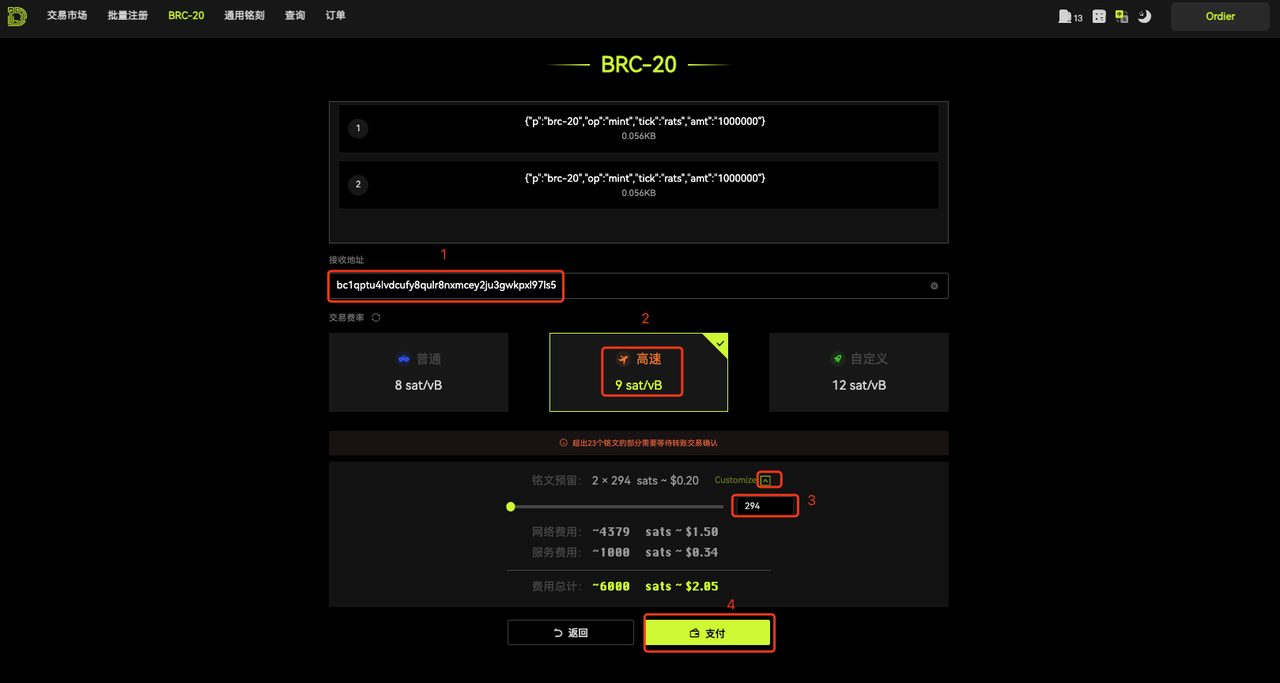
Receiving address: The default connected wallet address (can also be changed to other receiving addresses)
Transaction rate (gas fee): The default is high speed, and custom setting of gas fees is supported. Note: The gas fee on the chain fluctuates greatly, which may lead to casting failure. Its the same for all platforms.
Inscription reservation: The reserved satoshi can be customized and adjusted. It is recommended to use an address starting with bc 1 q, so that the reserved satoshi is reduced to a minimum of 294 and the cost is the most economical.
5. After confirming that the transaction rate and other information are correct, click Pay, cast, and confirm payment.
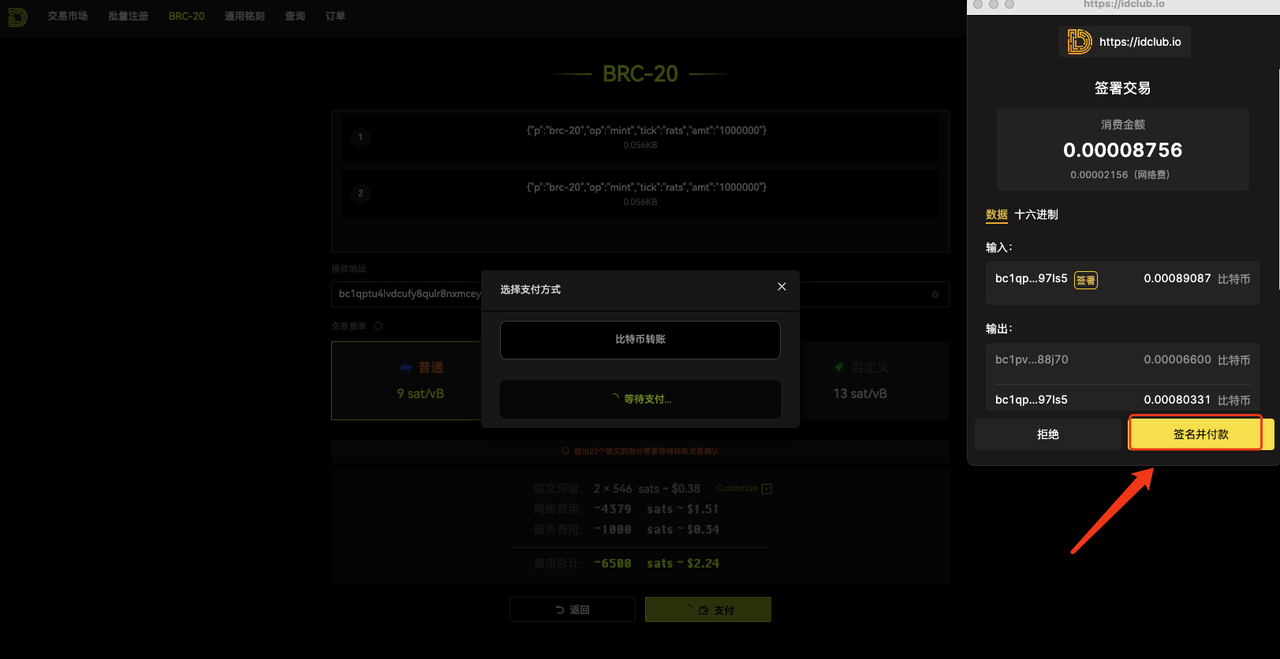
6. After the payment is successful, it will automatically jump to the order page, displaying the order ID, amount, rate (gas fee when submitting the order), quantity, inscribed content (cast inscription), payment address, order time, payment Status, engraving progress
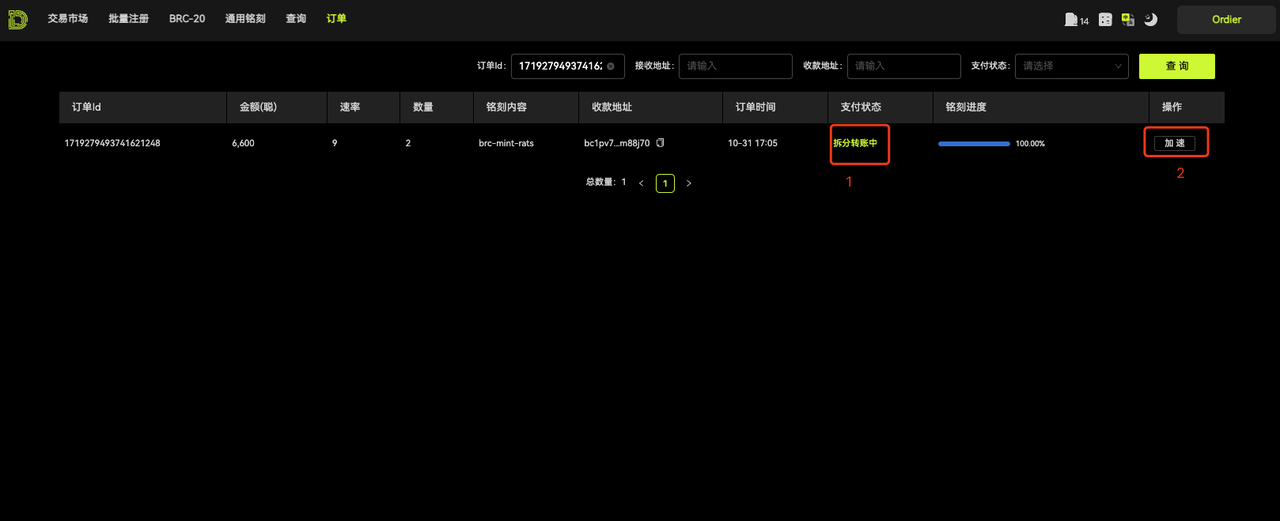
Acceleration: When the transaction rate (gas fee) is too low, it may cause transaction failure or slow transaction confirmation. In this case, order acceleration can be performed⚠️: Acceleration will cause additional acceleration fees.
7. After confirmation on the chain, the order status changes to Inscription Completed. Click on the wallet to see the cast inscription.
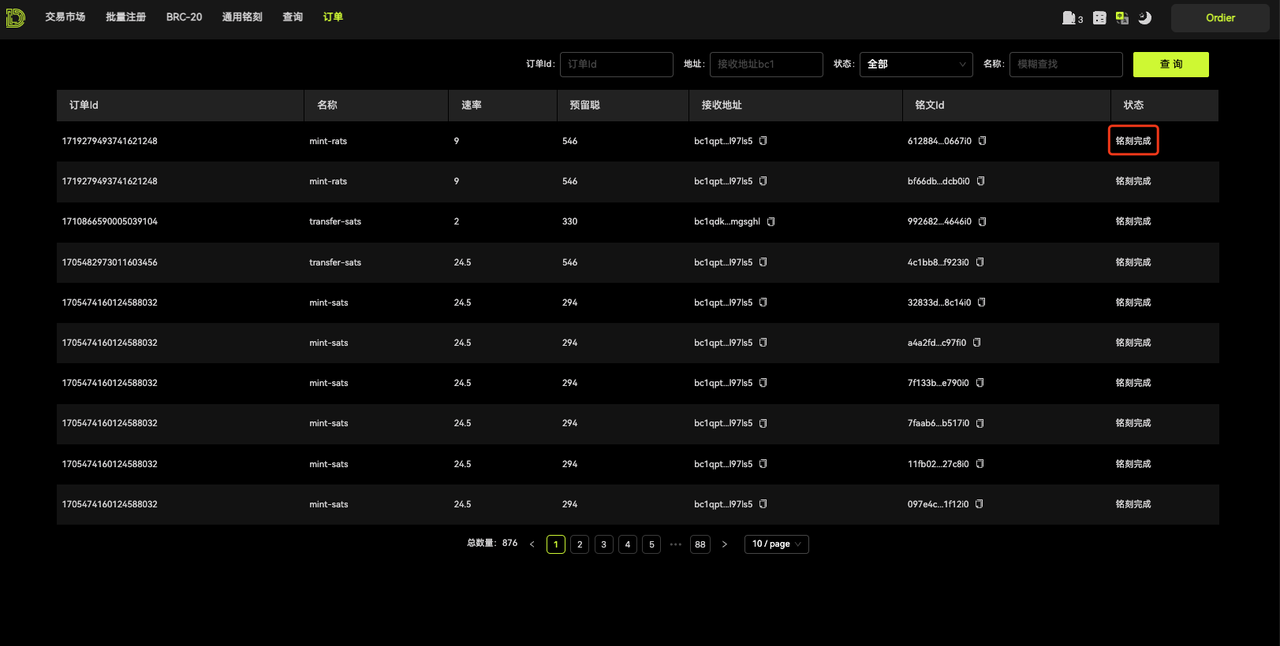
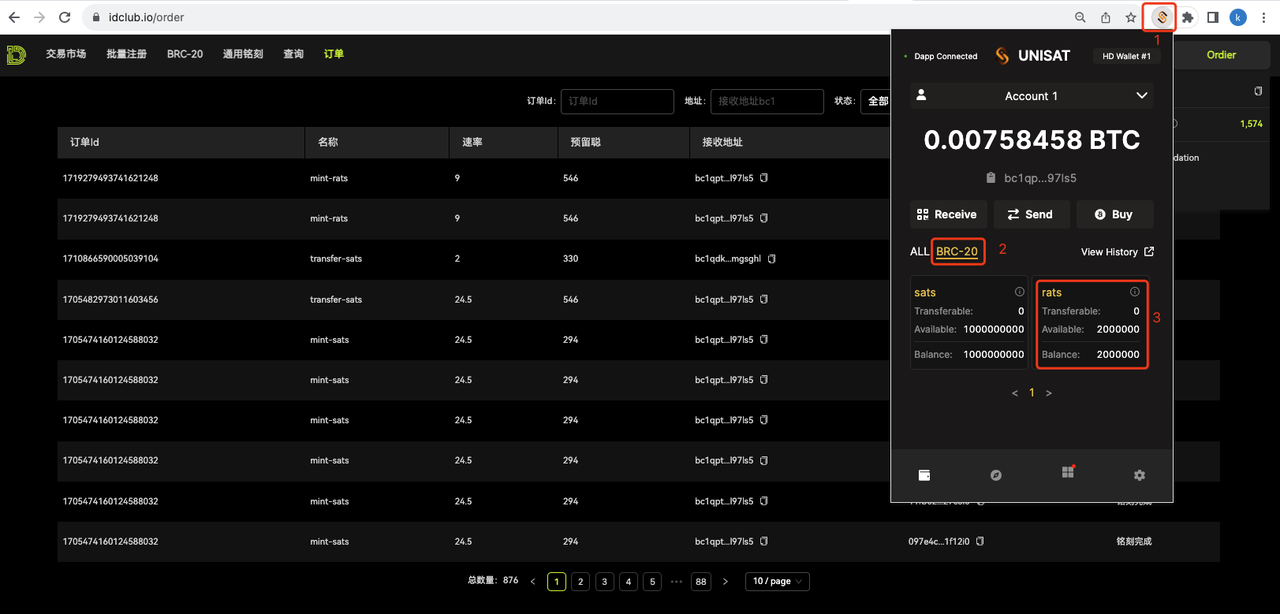
8. How to sell BRC-20 tokens?
The buying and selling of BRC-20 tokens is different. Selling inscribed tokens requires engraving a transfer inscription. Let’s take iDclub as an example to show how to sell BRC-20 tokens.
Click the wallet address where you connect to the wallet to enter the personal assets page.
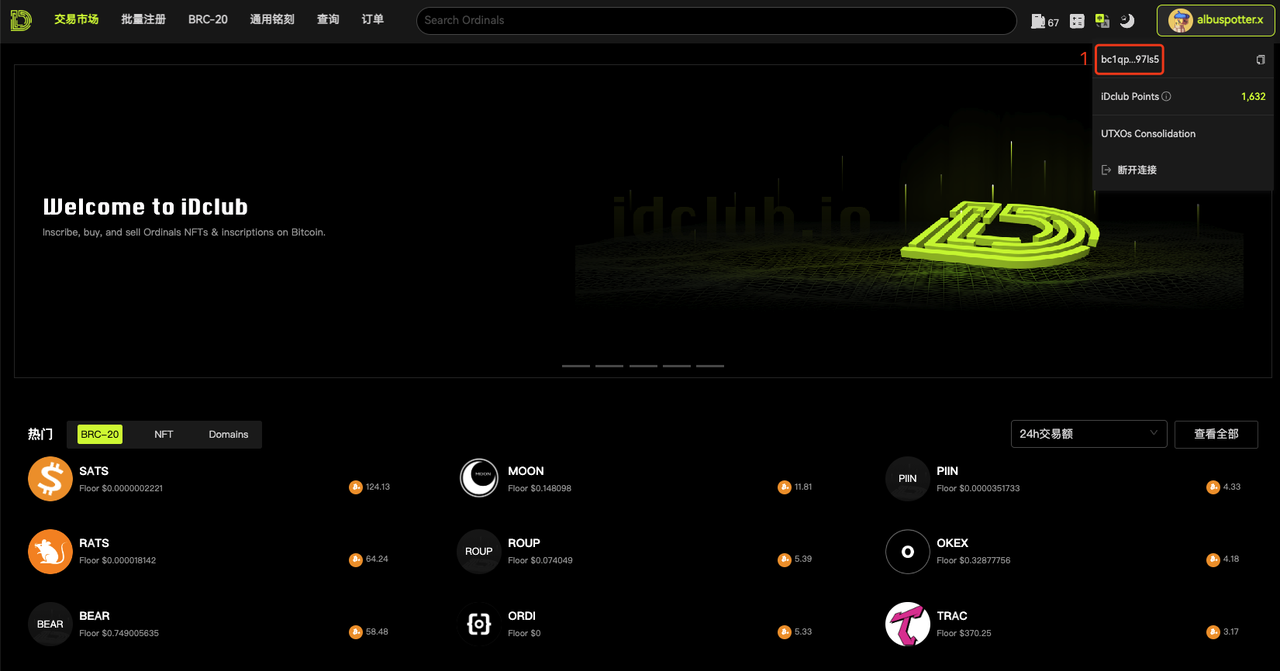
Click My Inscriptions and all the inscriptions in the wallet will be displayed. They are available for sale. You need to engrave the transfer inscription first.
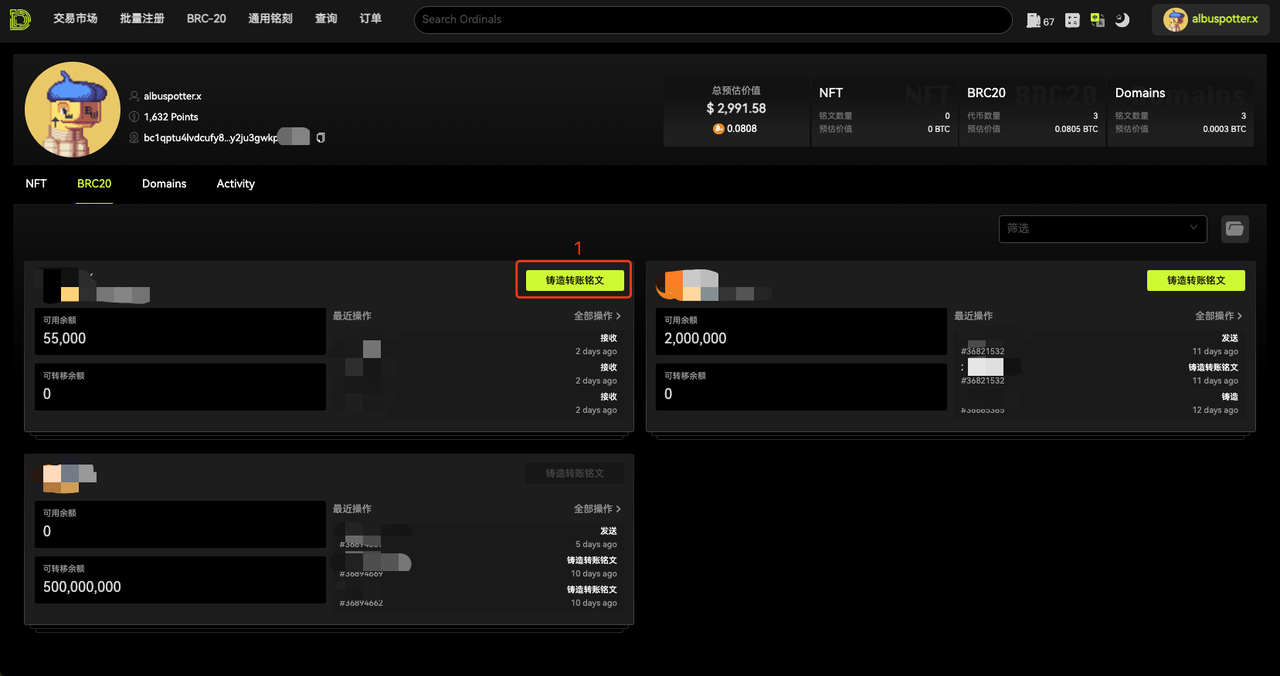
Select transfer amount and number of transfers
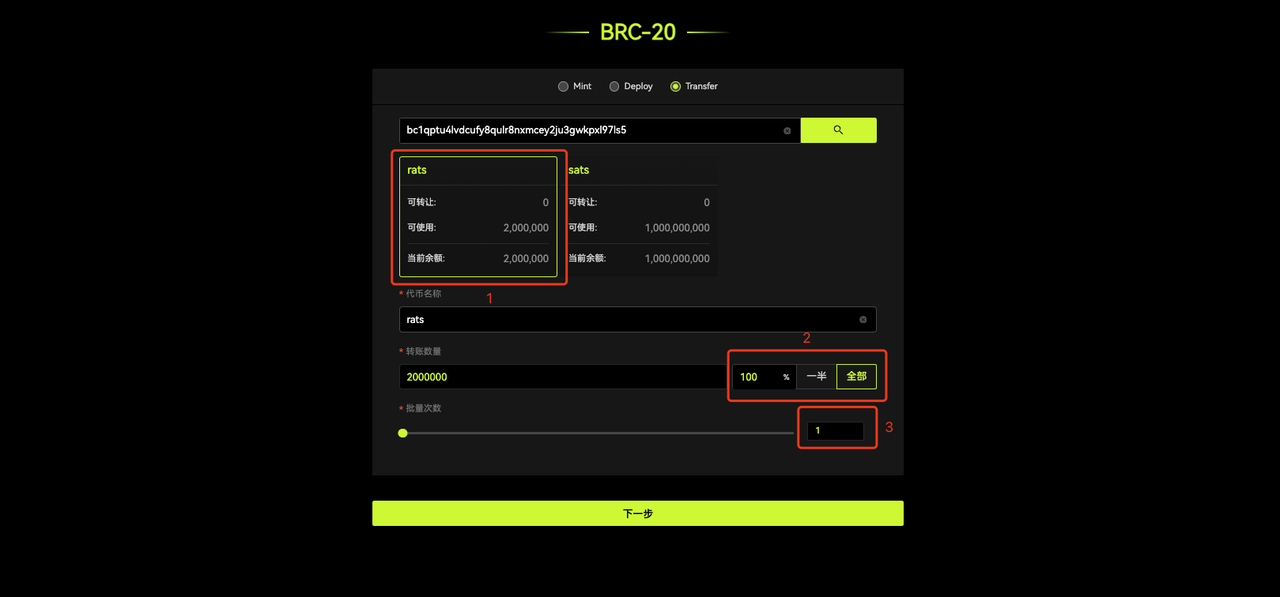
The transfer quantity is customized according to the quantity that needs to be sold.
Number of batches: It is divided into several parts. If the transfer quantity is 100 and the batch is 2, there are 2 inscriptions with a quantity of 50.
4. Select the receiving address, rate and reserved satoshi.
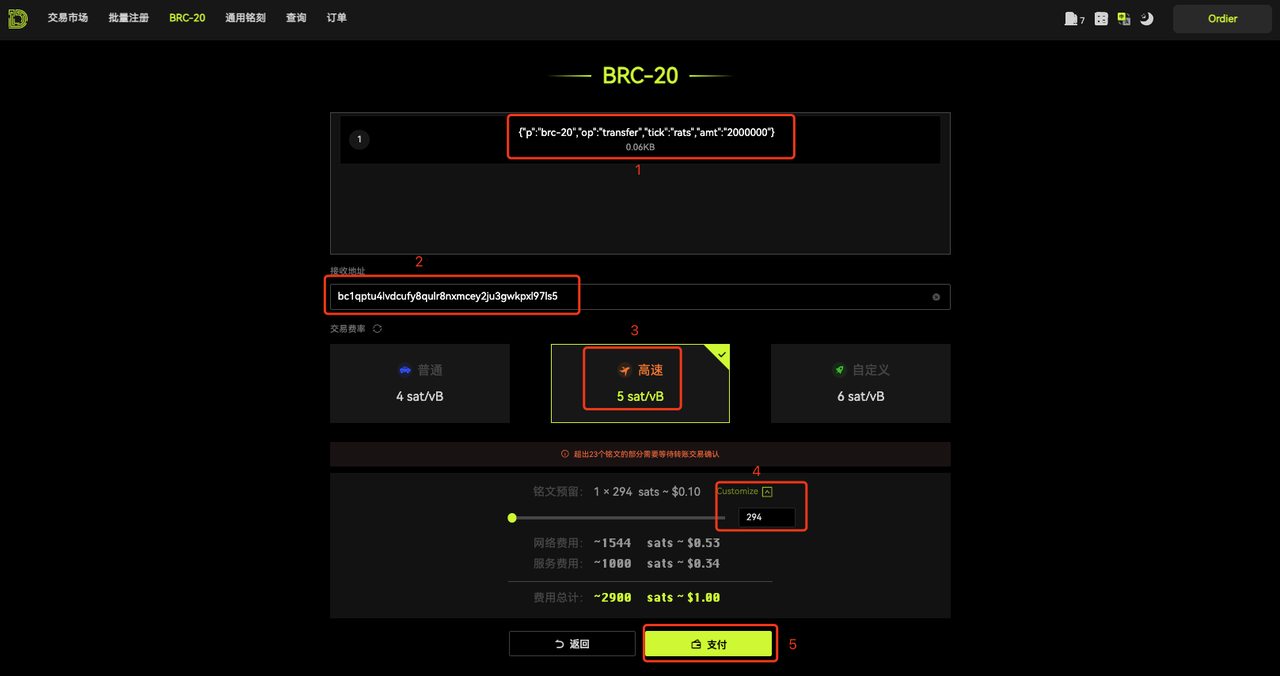
Receiving address: Defaults to the connected wallet address
Transaction rate (gas fee): The default is high speed, and custom setting of gas fees is supported. Note: The gas fee on the chain fluctuates greatly, which may lead to casting failure. Its the same for all platforms.
Inscription reservation: The reserved satoshi can be customized and adjusted. It is recommended to use an address starting with bc 1 q, so that the reserved satoshi is reduced to a minimum of 294 and the cost is the most economical.
5. After confirming the information in the pop-up box, click Sign and Pay to submit the casting transfer.
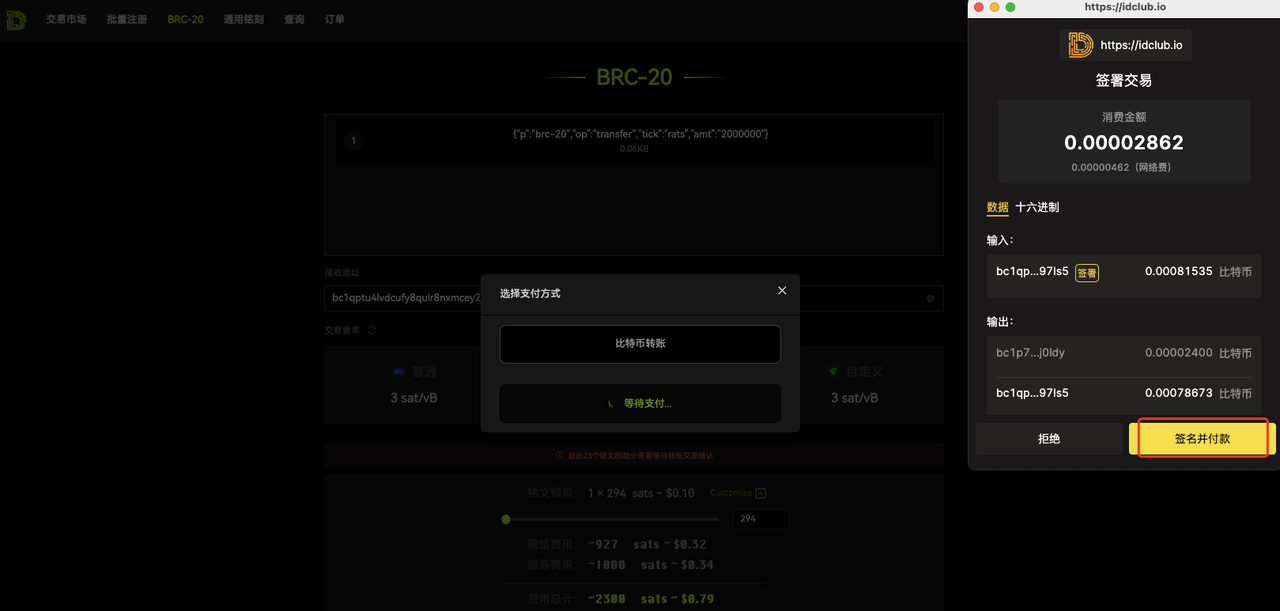
6. After the order is submitted successfully, it will automatically jump to the order details page, displaying the order ID, amount, speed (transaction rate), inscription content, order time, payment status and other information

Acceleration, when the transaction rate (GAS fee) is too low when the order is submitted, the estimate will fail or if you want to speed up the confirmation on the chain, you can use the acceleration function ⚠️Acceleration will incur acceleration fees
7. After the casting transfer is completed, return to the trading market My Inscriptions to put the inscriptions on the shelves for sale.

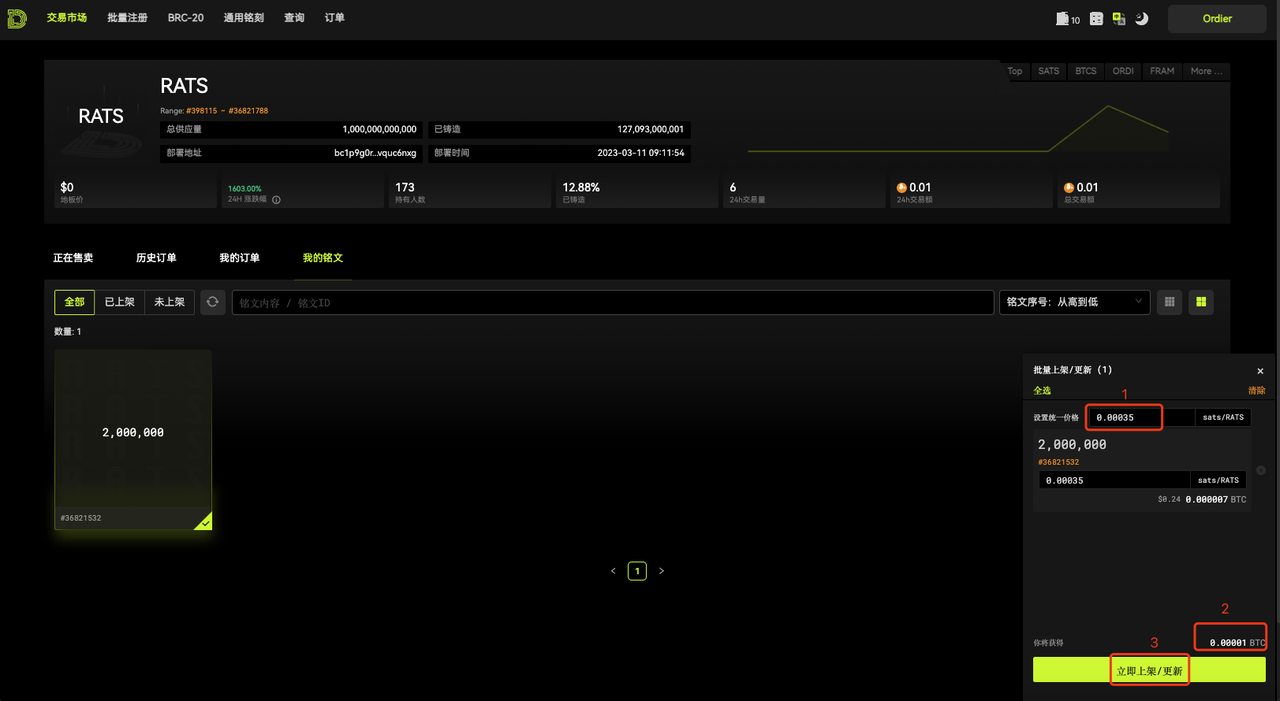
Click on the pop-up box in the lower right corner after listing and enter the amount for sale.
After confirming the listing price, click to launch immediately
8. Confirm that the information is correct and the wallet can be signed.
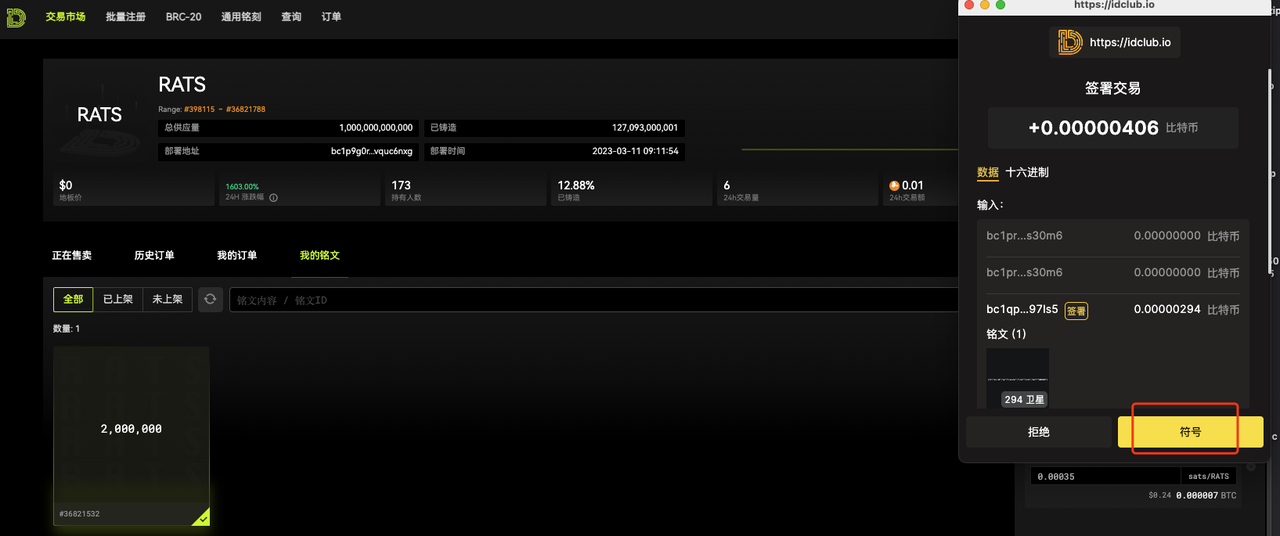
9. Update pending order price

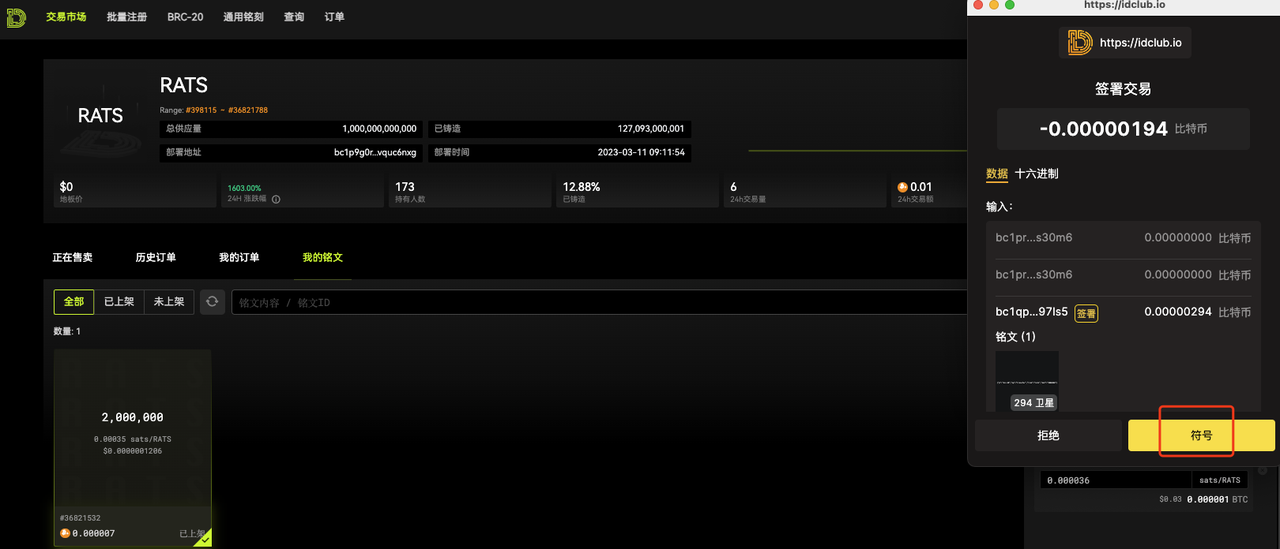
Enter the price to be adjusted
Clicking to update the shelf requires signature confirmation. Sign after confirmation, complete the price update, and wait for the order to be purchased.
9. How to buy BRC 20 tokens?
Inscription: can be purchased and cast. Casting is supported when the casting progress has not reached 100%. When the inscription progress reaches 100%, it can be purchased in the trading market. When the inscription is placed for sale in the trading market, it can be purchased. There is no need to wait until the casting progress reaches 100. % can only be purchased. The direct purchase price may be higher than the casting cost or lower than the casting cost. The price at the time of purchase shall prevail.
Search for the inscription you want to buy, take RATS as an example, click on the inscription to enter the detailed list, find the pending order with the right price, and click to buy
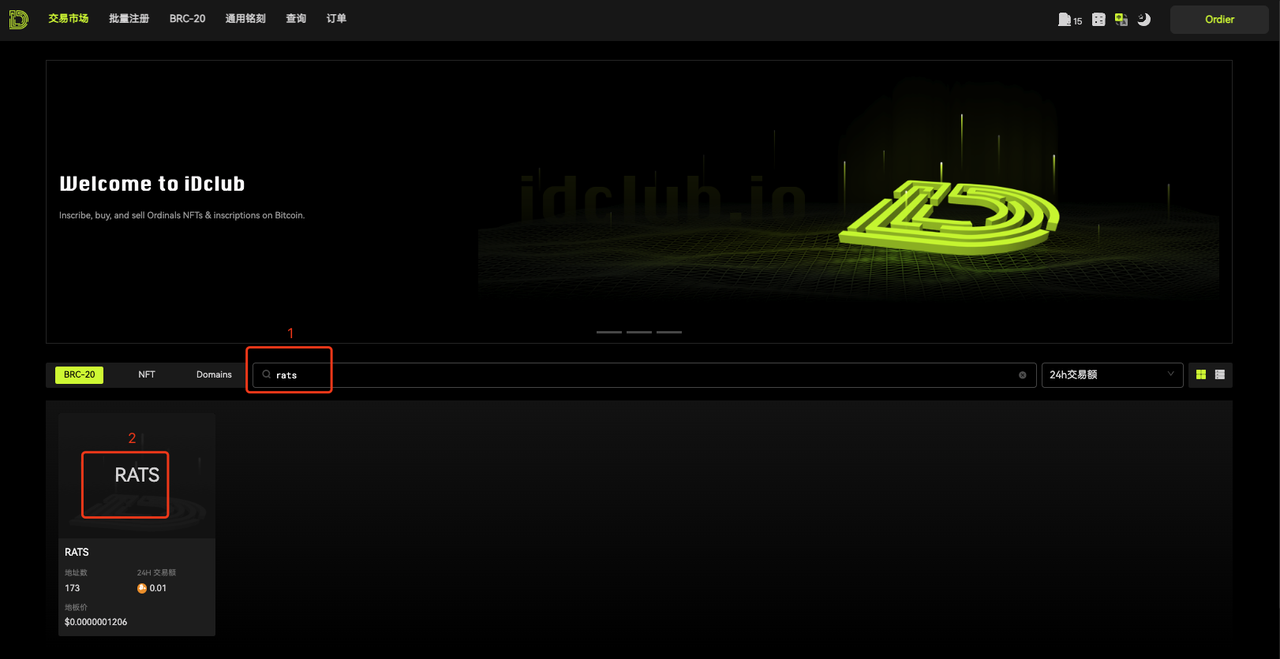
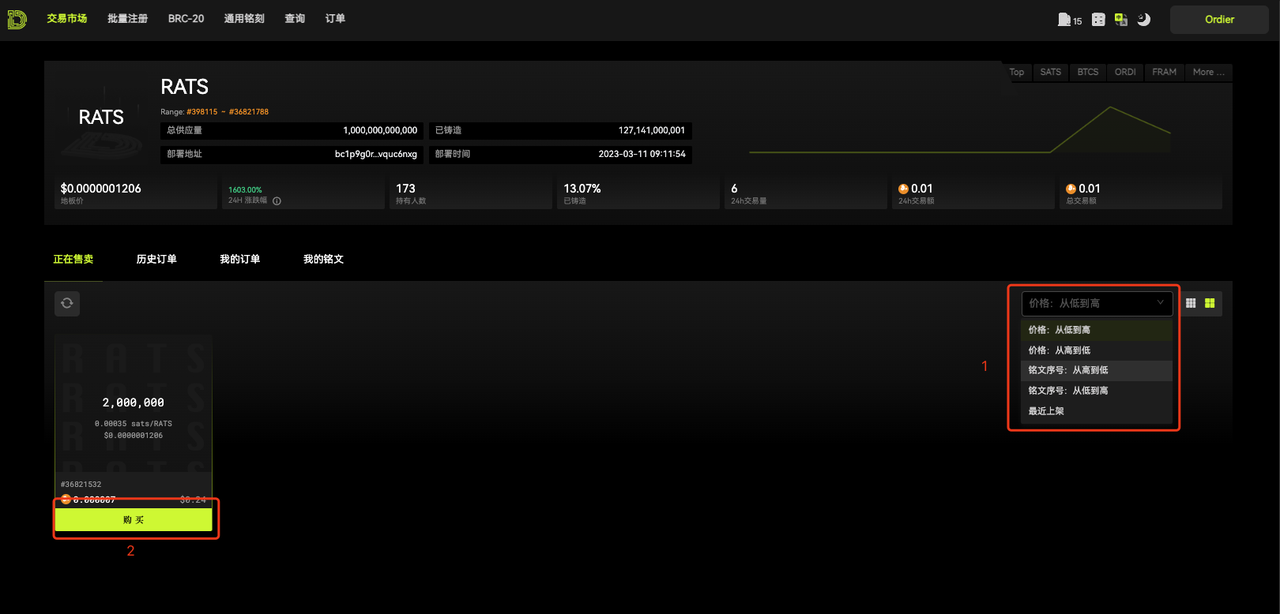
Confirm the transaction rate (GAS fee) of the purchase, which is high-speed by default and supports customization (⚠️The customized GAS fee cannot be too low, which will cause the transaction confirmation time to be too long) Confirm the signature.
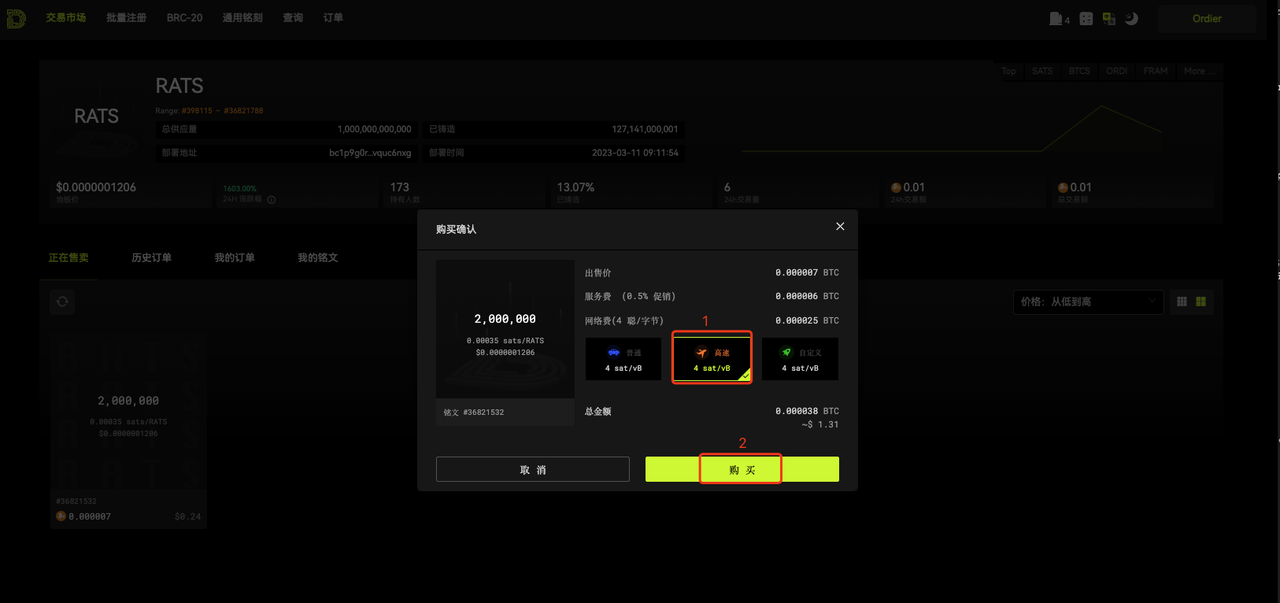
When purchasing, a wallet confirmation will pop up. After confirming that the information is correct, click Confirm. After confirmation, just wait for confirmation on the chain. After confirmation on the chain, the inscription of the purchase will be displayed corresponding to the wallet. Purchase completed✅
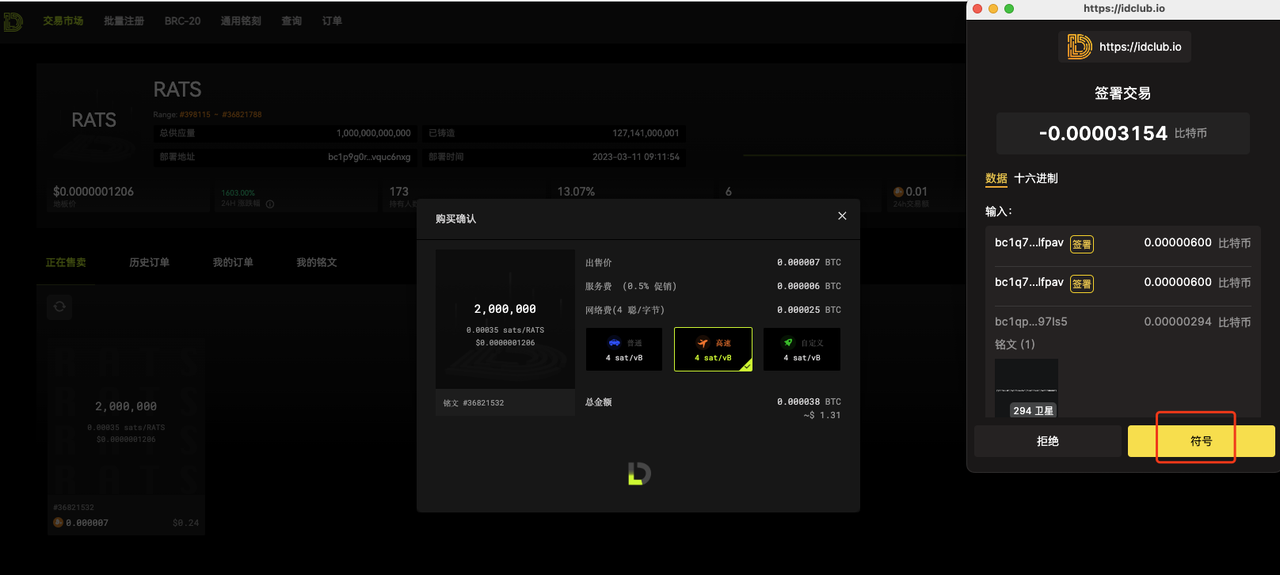
For more Ordinals expertise and news, you can also follow us on Twitter @idclub_ord.
[Disclaimer] There are risks in the market, so investment needs to be cautious. This article does not constitute investment advice and users should consider whether any opinions, views or conclusions contained in this article are appropriate for their particular circumstances. Invest accordingly and do so at your own risk.

